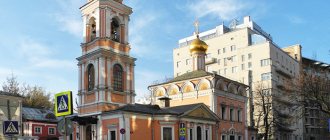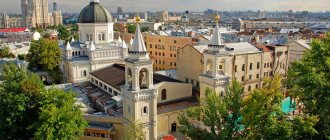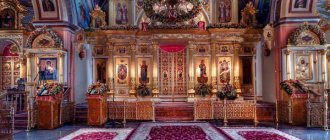Pokrovsky Monastery
Without exaggeration, we can say that this ancient monastery is known far beyond the capital. It became widely known due to the fact that the relics of Elder Matrona rest here. The Orthodox believe that they have miraculous powers.
In 1635, Tsar Mikhail Feodorovich founded the Intercession Monastery in Moscow. In those days, the territory occupied by the monastery was the outskirts where there were “poor houses” - a cemetery where homeless people and beggars were buried not only from all over Moscow, but also from its environs.
Little information has been preserved about the monastery. It is known that during the Russian-French war (1812) the monastery was destroyed. It took seven years to restore it. During Soviet times, the Intercession Monastery in Moscow was closed. On the site of the cemetery, a cultural and recreation park was laid out, which still exists today. For 70 years, the sacred premises of the monastery housed offices, a gym, a bank, and a billiard room.
In 1994, the Matrona Monastery in Moscow (as the Intercession Monastery is often called) received the status of a women's monastery. All borders were re-consecrated.
How to start preparing for monasticism
So, how can a woman go to a monastery? If the decision is made firmly, you can begin to prepare for monastic life. First, you need to begin the life of a churchgoer - regularly attend church services, confess, take communion, observe fasts, and try to follow the commandments. You can, with the blessing of the priest, serve in the temple - clean candlesticks, wash floors and windows, help in the refectory and perform any other assigned work.
It will be necessary to resolve all issues related to worldly affairs - determine who will look after the apartment or house (often future nuns simply sell their real estate and invest in equipping the monastery), resolve any legal issues, place pets, if any, in reliable hands. Next, you need to talk with your spiritual mentor and tell about your intention . The priest will help you choose a monastery and prepare for monastic life. It is imperative to receive the blessing of your confessor to leave life in the world.
Conception Monastery in Moscow
The monastery in its current form was founded in 1584, during the reign of Tsar Fyodor Ioanovich. On the territory of the temple there is the Spasskaya Church, which for many years was the home church of the Rimsky-Korsakovs.
Until 1924, the church was not a monastery, but a parish. In 1922, the Conception Monastery in Moscow was looted and destroyed. The monastery was restored only in 1991. The Cathedral of the Blessed Virgin Mary was erected and services are held there again.
Trip to the monastery
So, the preparation is completed , the blessing has been received, the monastery has been chosen. Now you should go there to talk with Mother Superior. She will talk about the features of life in the chosen monastery, about traditions and living conditions. You should have the necessary documents with you:
- Passport.
- A short autobiography.
- Marriage certificate or death certificate of spouse (if available).
- Request for admission to the monastery.
You should know that tonsure is permitted only to persons who have reached thirty years of age. If a woman has minor children, she will need to present a certificate of the establishment of guardianship over them by the responsible persons (sometimes they may also require characteristics of the guardians). You need to know that in this case the confessor may not give a blessing for monastic life and the abbess will advise you to stay in the world and raise your children. Staying in the monastery while having a minor child in the world is possible only in exceptional cases. The same applies to situations where a woman has elderly parents who need care.
There is no mandatory deposit of funds, but you can bring a voluntary donation.
From the history of the monastery
There is a legend that in 1591 the troops of the cruel khan Kazy Giray came close to Moscow. By decree of Tsar Fyodor Ioanovich, the miraculous icon of the Don Mother of God was encircled along the entire defensive line. When the sun rose, the Russian soldiers froze in amazement - the horde abandoned their positions and fled from the city walls. In honor of the miraculous icon, 2 years later a church was built of stone. So a monastery was founded here.
Typically, Moscow monasteries, photos of which you can see in our article, were built over several generations. In this sense, the Don Monastery was no exception. In the 17th century, the construction of the Great Cathedral was started by Princess Sophia, her work was continued by Peter I. Charitable financial assistance was provided by the boyar Artamon Matveev, Bogdan Khitrovo and the family of Stepan Razin. In the same 17th century, a wall was erected around the monastery. After the October Revolution, the monastery was abolished, but all its buildings were preserved. This is explained by the fact that the Museum of Architecture was located here in Soviet times.
Many consider the unexpected discovery of the relics of the Most Holy Tikhon, Patriarch of All Rus', to be the main event in the history of the monastery. Two years after his death (1925), the monastery was closed by the Bolsheviks. Rumors spread that Tikhon's body was burned in the crematorium; according to another version, it was reburied in the German Cemetery. The mystery was solved in February 1992, a year after the start of restoration work at the Donskoy Monastery. Participants in the excavations discovered the crypt of the patriarch.
Famous people who played a big role in the history of the country are buried in the necropolis of the monastery - the white generals Denikin and Kappel, the writers Shmelev and Solzhenitsyn, as well as Odoevsky, Chaadaev, the philosopher Ilyin. Today the monastery is part of the group “Operating Monasteries of Moscow”.
Thousands of tourists and pilgrims visit this holy place every year. By prior request, you can visit the bell tower and towers, the museum-cell of Patriarch Tikhon, and the observation deck.
Enter a monastery: stories of women who did this
Under the USSR, the explanatory dictionary interpreted monasticism as a form of passive protest against inhuman living conditions, which originated under the autocracy, as a gesture of despair and disbelief in the possibility of changing these conditions. Back then, when you heard the word “nun,” you only thought of an elderly granny who had never gotten rid of the prejudices of the past. Today, those who go to the monastery look completely different.
For example, romantic young ladies, “bookish” girls who got their ideas about monasteries from novels and films. Muscovite Larisa Garina in 2006 observed obedience in the Spanish monastery of the Discalced Carmelites (one of the strictest, with a vow of silence), prepared to take the vow and assured that only love for God brought her to these walls. “It’s hard for a week without sex,” Larisa assured, “but for the rest of your life it’s normal!” Today Larisa is happy, married, mother of two children. Youth is just youth to experiment.
A significant contingent are girls with problems who initially end up in the monastery only for a while. 25-year-old Alina 7 years ago, at 18, became addicted to drugs. “My parents sent me to a monastery for 9 months,” she recalls. — This is a special monastery, there were 15 novices like me. It was hard - getting up before dawn for matins, praying all day and poking around in the garden, sleeping rough... Some tried to escape, went to the field to find some grass in order to at least “kill themselves” with something. After some time, the body apparently cleanses itself. And a little later, enlightenment comes. I remember this state well: how the scales fall from my eyes! I completely came to my senses, reconsidered my life, and my parents took me away.”
“The monastery is also a kind of rehabilitation center for drinkers, homeless people,” Father Pavel, confessor of the Virgin Albazinsky Convent of St. Nicholas, confirms Alina’s words. — The lost live and work in the monastery and try to start a normal life.
Among those who went to monasteries there were many famous people. For example, the younger sister of actress Maria Shukshina Olga, daughter of Lydia and Vasily Shukshin. At first, Olga followed in the footsteps of her parents and starred in several films, but soon realized that she was uncomfortable in this environment. The young woman found the meaning of life in God, lived at an Orthodox monastery in the Ivanovo region, where her sick son was raised for some time. Olga carried out “obedience” - in addition to prayers, she baked bread and helped with the monastery’s household chores.
In 1993, actress Ekaterina Vasilyeva left the stage and entered a monastery. In 1996, the actress returned to the world and to the cinema and explained the reason for her departure: “I lied, drank, divorced my husbands, had abortions...” Vasilyeva’s husband, playwright Mikhail Roshchin, after her divorce with whom she left the world, assured that the monastery cured his ex-wife of alcohol addiction: “No matter what clinics she was treated in, nothing helped. But she met the priest Father Vladimir - and he helped her recover. I think she sincerely became a believer, otherwise nothing would have happened.”
Photo: Zhanna Golubitskaya
In 2008, People's Artist of Russia Lyubov Strizhenova (mother of Alexander Strizhenova) exchanged secular life for monastic life, waiting for her grandchildren to grow up. Strizhenova went to the Alatyr Monastery in Chuvashia.
The famous actress Irina Muravyova does not hide her desire to hide in the monastery: “What most often brings you to the temple? Illness, suffering, mental anguish... So grief and aching emptiness inside brought me to God.” But the actress’s confessor does not yet allow her to leave the stage.
xxx
I go to the courtyard of the Novospassky Monastery in the near Moscow region, known for accepting novices and also providing shelter for women victims of domestic violence. Moreover, the monastery itself is for men.
I tell the priest that I came to consult about my 20-year-old niece Lisa - they say she wants to go to the monastery and will not listen to any persuasion.
Father, Father Vladimir, reassures:
- You bring her. We won’t take it, but we’ll definitely talk. There must have been unrequited love. Age has its place... She can’t go to a monastery! You cannot come to God out of grief and despair - whether it is unrequited love or something else. People come to the monastery only out of conscious love for God. Just ask Mother Georgia, she came to the sisterhood 15 years ago, although everything was fine with her - both work and home were full.
The sister, and now mother, named in the monastery in honor of St. George, was called differently in the world. Despite her black clothes and lack of makeup, she looks about 38-40 years old.
“I came at 45,” my mother smiles slyly, “and now I’m 61.”
Either an enlightened look gives such an effect, or a relaxed, kind face... I wonder what brought her to God?
- Do you have a goal in life? - Mother answers the question with a question. - And what is she like?
“Well, to live happily, to love children and loved ones, to bring benefit to society...” I’m trying to formulate.
Mother Georgiy nods her head: “Okay, but why?”
And no matter how hard I try to find an explanation for my seemingly noble goals, I always come to a dead end: really, why? It turns out that my goals seem to be not lofty, but vain. Small troubles - all so that you can live comfortably, so that neither conscience nor poverty disturbs you.
“Until you realize the purpose of your earthly life, there is nothing to do in the monastery,” summarizes Mother Georgia, and Father Vladimir smiles approvingly. “I came when suddenly one fine morning I realized why I was living.” And I woke up with a clear understanding of where to go. She didn’t even come to the monastery; they brought the legs themselves. I left everything without a second thought.
- And have you really never regretted it?
“This is a state when you clearly see your path,” mother smiles. “There is no room for doubts or regrets.” Bring your Liza, we’ll talk to her, tell her that she doesn’t need to give up the bustle of the world - it’s too early. Going to a monastery just because of troubles in your personal life is not good! Yes, and from the young flesh there will still be temptations; she will have no time for prayer. But we definitely need to talk: otherwise, if she’s stubborn, some kind of sect can lure her.
- Don’t you hire young people at all? But who are these women? — I point to a group of women in black robes working on a plot of land. Some of them seem young.
“There are those who are waiting for tonsure,” explains the priest, “but they have been here as novices for a long time, they have already tested their love for the Lord.” In general, the abbot usually does not give a blessing to a woman until she is 30 years old. There are those who are simply obedient; they can always leave. And there are those who ran away from their monster husband, they live over there, some with children,” the priest points to a separate log house. We will shelter everyone, but in order to somehow live, we must work in the monastery economy.
—Are there those who are not accepted as nuns on principle?
“The contraindications are about the same as for driving,” the priest smiles, pointing his finger at his car. - Epilepsy, mental disorders and drunkenness.
xxx
But why can one be drawn to a monastery by such happiness, if grief and disappointment are not allowed? My conversations with those who were just going to the monastery or visited, but returned to the world, show that such thoughts do not come from a good life.
Elena, a Muscovite, had an adult daughter in a terrible accident. While they were fighting for her life in intensive care, she vowed that she would go to a monastery if the girl survived. But the daughter could not be saved. A year after the tragedy, Elena admits that sometimes it seems to her that her daughter died in order to save her from monasticism. Because Elena is glad that she did not have to fulfill her promise and give up worldly life. Now the orphaned mother reproaches herself for not having formulated her thought differently: let her daughter survive - and we will live and enjoy life to the fullest together.
32-year-old Saratov resident Elena admits that a year ago she wanted to go to a monastery; depression was caused by serious complications after the operation. Today Lena is happy that there were kind people who managed to dissuade her:
“My confessor, as well as my family, friends and psychologists kept me from taking this step. I found a good father, he listened to me and said: you have a family - this is the most important thing! And he advised me to contact an Orthodox psychologist. Today I understand that my desire to go to a monastery was only an attempt to escape from reality and had nothing to do with the true desire to come to God.
“The desire of girls to enter a monastery is most often an attempt at self-realization in this way,” confirms Ellada Pakalenko, a psychologist with a rare “Orthodox” specialization. She is one of the few specialists who works specifically with “monasticism” - those who want to leave worldly life, but have doubts. They come to Hellas themselves, sometimes they are brought by relatives who are unable to dissuade their loved ones from such a step on their own. It was Pakalenko who helped Lena from Saratov escape the monastery cell. Hellas knows what she’s talking about: she herself went to the Donetsk monastery as a novice at the age of 20.
Hellas Pakalenko. Photo: from personal archive
“In general, general flight to monasteries is always accompanied by an economic crisis, genocide and overpopulation,” says Hellas. — If we look at history, we see that mass exoduses of the laity always occur against the background and as a consequence of a sick society. And the mass exodus of women is a sure sign of pressure on them. This happens when women stop coping with the task assigned to them and want to throw off the burden of responsibility by trusting in God. And from time immemorial, girls have been raised with very high demands: she must be a wife, a mother, a beauty, and educated, and be able to feed her children. And boys grow up irresponsible, feeling that they themselves are happiness and a gift for any woman.
xxx
An Orthodox psychologist is sure that going to a monastery replaces unrealized love for a woman:
— As practice shows, girls who go to the monastery are not from church-going families at all, but emotionally closed ones, with low self-esteem and weak sexuality, believing that only within the monastery walls they will be “understood.” They don’t understand that this is not a solution, and certainly not good for God. A monastery is also not the best place to pacify the flesh: girls with normal sexuality who try to suppress it in this way will have a hard time in a monastery. In the sense that they will not find the peace they are looking for there.
Pakalenko says that she visited many monasteries, talked with novices and nuns, and can say exactly what brings yesterday’s carefree girls to their cells. These are poor relationships with parents, especially with the mother, low self-esteem and perfectionism.
— In one monastery I saw such nuns that Hollywood is resting! - Hellas recalls. — Tall, slender girls with model appearance. It turned out, indeed, that they were yesterday’s models, kept women of rich people. And they have such a challenge in their eyes and in their speeches: “I feel better here!” For young people, a monastery is always an escape from problems, from failures. An attempt to “change coordinates” in one’s own life so that they are treated differently. This is not bad, but this is not about true faith, but about the fact that these girls have no other tools to change their lives - not to be discouraged, to work, to study, to love. This is about weakness and lack of will to live, and not at all about love for God. Good confessors dissuade such people. But all sorts of sects, on the contrary, search and lure. Sects always need fresh blood from the disappointed, desperate, and morally unstable. And they always lure precisely because they promise being chosen: “We are special, we are different, we are higher.”
Hellas talks about his own journey into the monastery walls. It was in her native Donetsk, she was 20, she was a stately and beautiful girl, she enjoyed increased attention from men, for which she was constantly reproached in her strict family. At some point, she wanted a pause—inner silence—to get to know herself. And she ran away to the monastery. 20 years have passed since then, and Hellas assures that there is a way back from the monastery. Although it is certainly not easy.
“I know what it’s like to live in a monastery as a novice, and then understand that it’s not yours, and leave there and return to these walls only as a specialist - a “dissuade” from the monastery. Now I’m 40, I teach people to believe in God and keep his commandments, and not to isolate themselves from the outside world simply because they don’t have the strength to get what they want, to resist violence, evil, pain.
Hellas recalls that at the monastery, in addition to novices and nuns, there were simply women with children who had nowhere to go. All the inhabitants of the monastery walls had their own stories, but no one was taken to monastic vows right away. It was necessary to stay in the monastery for at least six months and, if the desire persisted, to ask for the blessing of the abbess. Mostly these were simple women, without special requests or education.
xxx
An expert on Orthodox ethics and psychology, Natalya Lyaskovskaya, admits that after the onset of the crisis, there were more women who wanted to retire from the world. And he identifies 5 main types of “candidate nuns.”
Natalya Lyaskovskaya. Photo: from personal archive
1. Today, students of monasteries most often become nuns. In Russia there are many shelters where orphan girls, those who have lost their parents, and children from disadvantaged families find protection, care and care. These girls grow up in convents under the tutelage of sisters in Christ, who not only care about the physical health of their pupils, but also the mental health - they treat the children with the love that they were deprived of. After graduating from high school, they can leave the walls of the monastery and find their place in society, which is not difficult with the acquired skills. However, often girls remain in their native monastery for the rest of their lives, take monastic vows and, in turn, work in shelters, nursing homes, hospitals (for obedience), in schools - and at the monasteries there are music, art, and pottery workshops. and other schools, not only general education and parish schools. These girls cannot imagine life without a monastery, outside of monasticism.
2. The second common reason why adult girls and women come to the monastery is a great misfortune suffered in the world: the loss of a child, the death of loved ones, the betrayal of a husband, etc. They are accepted for obedience if for a long time a woman still wants to become a nun and the Mother Superior sees that she will become a nun, she is tonsured. But more often than not, such women gradually come to their senses, gain spiritual strength in the monastery and return to the world.
3. Unfortunately, there is also a category of women who come to the monastery to “settle in better”: it seems to them that in the monastery “everything is for free” and life is smeared with honey. However, the hardships of service and obedience quickly discourage such people.
4. There is another category of women over whom our monasteries are increasingly taking guardianship. These are women who failed to integrate into the social model of society or for some reason were thrown to the margins of life: for example, they lost their homes due to the fault of black realtors, were expelled from home by children, drinkers, and are struggling with other addictions. They live in a monastery, are fed by it, work as best they can, but they rarely become nuns. It is necessary to go through a long spiritual path for the monastic spirit to kindle in such a person.
5. Sometimes there are exotic reasons: for example, I know one nun who went to the monastery (besides her sincere spiritual disposition towards the monastic way of life) because of the unique library that the monastery she chose had. In one of the Siberian monasteries there is a black girl, she came to Russia specifically to become a nun and “live in silence”: in her homeland she had to live in a black ghetto, where there was terrible noise day and night. The girl received holy baptism and has been tonsured a nun for four years now.
Father Alexey Yandushev-Rumyantsev. Photo: from personal archive
And Father Alexey Yandushev-Rumyantsev, prefect for educational and scientific work at the Higher Catholic Theological Seminary in St. Petersburg, explained true female monasticism to me:
“The Church sees a special blessing in women’s choice of the monastic path - as always, when its children devote themselves to prayer and spiritual feat for the world and for all humanity, for this is love for one’s neighbor. Today, as in all previous eras, starting from the early Middle Ages, among the people who devoted their entire lives to serving God and prayer, the majority were women. The experience of our life suggests that, being delicate and defenseless by nature, women are in fact often stronger and incomparably more selfless individuals than men. This also affects their life choices.”
Novodevichy Convent
There are monasteries in the capital that are widely known throughout Russia. These are very ancient monasteries in Moscow. The existing monasteries (this is clearly visible on the map) are located not only in the center, but throughout the city.
The Novodevichy Convent is rightfully considered one of the most beautiful in Moscow. It was founded in 1524 in honor of the return of the Russian city of Smolensk to the Moscow Principality by Prince Vasily III. There is no consensus on the name of the monastery. According to one version, the abbess of the monastery had the surname Devochkina. According to another, on the site of the current monastery there was a field where beautiful girls were chosen and sent to the Golden Horde. The most likely version is that the monastery was intended for girls; the prefix “new” appeared only to distinguish the new and already existing convents in Moscow from each other.
For a long time it was the richest and most privileged monastery in Russia. Women from noble families went to this monastery. When they were tonsured, they donated their jewelry - gold, pearls, silver, sapphires and diamonds. By the middle of the 17th century, a magnificent ensemble in the Moscow Baroque style was fully formed here. The towers began to be decorated with openwork crowns. The second tallest bell tower and the Assumption Church were built. During its long history, the Novodevichy Convent has seen within its walls also residents who crossed the threshold of the monastery against their will. Here, the noblewoman Morozova, Princess Sophia, was in custody, who was imprisoned in the monastery by Peter I; Evgenia Lopukhina, the first wife of Peter I, was also transferred here (shortly before her death).
It can be considered a miracle that the monastery was not damaged in 1812. However, he could not avoid the fate that befell all monasteries in Russia during Soviet times. In 1922 it was closed, and a historical museum began operating on its territory.
All male and female monasteries in Moscow are historical and architectural monuments. The Novodevichy Convent is included in the UNESCO heritage list.
Holy convents
Women's monasteries in Russia.
Contents of the article: 1. Formation of convents in Russia 2. Alekseevsky Convent 3. Annunciation Convent 4. Epiphany Convent 5. St. Nicholas Convent 6. Kashin Convent 7. Peter and Paul Convent
The territory of a complex of liturgical, economic and residential buildings, usually enclosed by a fence, is called a monastery, where a religious community of monks or nuns is located.
The word “monastery” translated from Greek means “lonely”, “alone”. Currently, there are 455
men's and
471
women's Orthodox monasteries in Russia. The article talks about some of the nunneries that are of interest to history buffs and pilgrims.
Formation of convents in Russia
Historians have established that monastic life appeared in Ancient Egypt in the 4th
century, thanks to the monk Pachomius the Great, the founder of the Christian monastic community.
Then hermits settled in communities far from cities, and devoted their lives to serving Jesus Christ. Subsequently, these places were called monasteries. In Kievan Rus, the first convents for women arose 20
years after the adoption of Christianity under the auspices of the Holy Synod of Monasteries.
After about 1.5 centuries, they become the center of culture and education and thus play a large role in the economic and political life of the ancient state. In the 17th
century, all women’s monasteries were conditionally divided into three groups: the first included monasteries created during the Russian settlement of the territory between the Dniester and Don (“Wild Field”). The second group included monasteries formed on the basis of women's religious communities. The third is church institutions, which originated as male, but were later transformed into female for various reasons.
Alekseevsky Convent
At a distance of 115 km
from Yaroslavl is the city of Uglich, where the Alekseevsky Convent, built in
1371
.
Moscow Prince Dmitry I Ivanovich Donskoy gave his consent to the construction of the monastery. Historical documents indicate that this place used to be the sacred place of a pagan deity. The monastery territory was surrounded by a wooden fence; it protected the city from Yaroslavl. Initially, the monastery was called “Uspenskaya”, but after 68
years it was renamed in honor of the Bishop of Kiev and All Russia Alexy and is still called “Alekseevskaya”.
During the Polish-Lithuanian intervention in 1609
, the monastery defended itself from the army of Jan Sapieha, but, despite stubborn resistance, it was captured and its defenders exterminated.
In 1628
, the Assumption Church was built in the monastery in memory of the dead residents and monks of Uglich, named “Wonderful” because of its beauty and grandeur.
On the territory of the monastery, the Alekseevsky Church, erected at the beginning of the 16th
century, the Church of John the Baptist and other buildings of those times have been preserved.
In 1930
, the monastery was closed, and part of its premises were used for city housing.
At the end of the 20th
century, all the buildings of the Alekseevsky Monastery were transferred to the Russian Orthodox Church. Nowadays there is a women's monastery here.
Annunciation Convent
In Kirzhach (125 km
from Yaroslavl), the Annunciation Monastery of the Alexander Diocese of the Russian Orthodox Church is considered one of the main attractions of the city.
Chronicle sources say that Hieromonk Sergius of Radonezh and his monks went to look for a place to build a new monastery. The place was chosen on the banks of the Kirzhach River, where monastic dwellings and a wooden church were built. After 4
years, Radonezhsky returned to his permanent place of residence (Trinity Monastery), leaving in his place his student monk Roman, later named Roman Kirzhachsky.
In the 16th
century, the wooden church building was dismantled and a stone temple was erected in its place.
After completing construction work and decorating the interior with frescoes, the church was consecrated in the name of St. Sergei of Radonezh. At the beginning of the 20th
century, in addition to the Radonezh Church, the Annunciation and Spasskaya churches, cells and outbuildings were located on the territory of the monastery.
The date of construction of the Annunciation Cathedral is unknown, but historians believe that it was erected at the beginning of the 16th
century, and the Church of the Savior was erected in
1656
at the expense of the boyar Ivan Miloslavsky as the family tomb of the Miloslavsky dynasty.
After the revolutionary events, church services were suspended, the monastery was closed, and the Radonezh temple building was blown up. During the Second World War, the cathedral premises were used as an ammunition depot, and the Church of the Savior at different times housed a sausage shop, workshops of the city bakery and other institutions. In 1990
, the monastery buildings were returned to the Russian diocese. After five years of restoration and restoration work, the Annunciation Monastery resumed its activities, but as a convent.
Epiphany monastery
Avraamiev Epiphany Convent
is located in Rostov and is included in the list of the main attractions of the city, founded in
862
.
According to the chronicles of those times, on the site of the built monastery there stood the patron saint of poetry, the idol of Veles. The deity of the ancient Russian pagans was destroyed thanks to the disciple of Jesus Christ, John the Theologian. Having appeared at this place during the prayer of the monk, Abraham gave him the rod. This symbol of divine power was used to destroy the statue. Soon Abraham founded an Orthodox monastery here. There is no historical data about the formation of the monastery, but many historians attribute it to the 14th
–
15th
centuries.
The rod was in the monastery for a long time. The first Russian Tsar Ivan the Terrible, before the capture of Kazan, while making a pilgrimage, took with him a sacred staff, which, in his opinion, helped him win. As a token of gratitude to them, a temple in the name of the Epiphany of the Lord was erected on the monastery territory (one of the first cathedrals the 16th
century).
6
after the revolution, the monastery was closed, and all monastic buildings were transferred to the disposal of the Rostov Museum of Antiquity, the clergy and monastic community continued to perform services in the Assumption Church in Rostov.
In 1990
, at the request of the Holy Synod, the territory of the monastery, the Epiphany Cathedral, the Vvedenskaya and St. Nicholas churches were transferred to the Russian Orthodox Church.
In 2004
, after restoration work was completed, the monastery was transformed into the Epiphany Convent.
St. Nicholas Convent
In 1580
, the St. Nicholas Convent was founded in Arzamas.
The Tambov Bishop Feofilakt Yakovlev was entrusted with supervising the construction of the monastery. The very first building was the wooden St. Nicholas Church, where a women's community was founded. The wooden building burned several times. This led to the decision being made in 1683
to build a stone St. Nicholas Church on this site.
In 1811
, the foundation of a new temple was laid and two years later it was consecrated in the name of the Epiphany of the Lord.
In 1924
, the monastery was abolished, but
70
years later the St. Nicholas Convent for women, with the blessing of the Holy Synod of the Russian Orthodox Church, restored its activities.
Kashin women's community
In the city of Kashin (the regional center of the Tver region), on the left bank of the Kashinka River there is an active convent of Nikolaevsky Klobukov
.
The first cathedral was built in honor of the wonderworker Nicholas of Myra (patron of travelers, prisoners and orphans). The name of this saint gave the first word in the name of the monastery. The second word - “Klobukov” is associated with Bishop John of Novgorod. According to a legend that has survived to our time, the miracle worker pacified the demon and forced him to be taken to Jerusalem. Flying over the bank of the Kashinka River, the saint dropped his hat. The monastery was founded on this site. In 1929
, the monastery was abolished and sausage production workshops were located on its territory, and then workshops for the production of pottery. At the request of the Holy Synod, the city leadership transferred all the monastic buildings (Trinity Cathedral, Intercession and Alekseevskaya churches) to the Tver diocese and in 1990 the revival of monastic life began, but as a convent.
Peter and Paul Monastery
Pilgrims
can visit the Peter and Paul Convent
60
km from The decision to build a monastic monastery on the shore of the largest lake in the Khabarovsk region, Peter and Paul, was made in 1905
, but for various reasons the start of construction was suspended.
At the beginning of the 21st century, according to the resolution of the Khabarovsk church leadership, construction resumed. In 2004
, the construction of the main cathedral in the name of Saints Peter and Paul was completed and consecrated, modeled on Russian churches
of the 12th
century.
The Women's Peter and Paul Monastery, built in 2003 , is considered the center of Orthodoxy in the Khabarovsk region and belongs to the Amur diocese.
St. Daniel's Monastery
This is the very first male monastery in Moscow. It was erected in 1282 by Prince Daniil, the son of the legendary Alexander Nevsky. After 11 years, it was plundered and destroyed by the Tatar-Mongols. For two centuries, only a tiny temple and cemetery reminded of it. The monastery gained greatness only during the time of Ivan the Terrible. In 1611, the monastery was set on fire by order of False Dmitry. It was restored, but in 1812 it was again desecrated and looted. The magnificent ensemble that we see today was formed in the 17th – 19th centuries.
During Soviet times, the monastery was one of the last to be closed in Moscow. This happened in 1930. The cemetery was destroyed, and the graves of famous Russian figures were moved to the Novodevichy and Donskoy monasteries. A common occurrence for that time, unfortunately...
The currently operating monasteries in Moscow were gradually returned to the Orthodox Church. St. Daniel's monastery became the very first. This historical event took place in 1983. Five years later, the monastery hosted the main celebrations on the occasion of the 1000th anniversary of the Baptism of Rus'. Today here is the residence of the Patriarch of All Rus'.
Required qualities
Going to a monastery - what is needed for this ? A lot is needed, first of all you need to have a number of qualities, namely:
- Sincerely believe in God.
- Have humility and great patience.
- Constantly work on yourself, fighting your own passions, sinful thoughts and vices.
- Give up any bad habits.
- Refusal of any manifestations of worldly vanity.
- Love of prayer.
- Love for your neighbor and all living things.
In addition, it should be borne in mind that nuns are constantly engaged in hard physical labor to earn their living, so it is very desirable to have good physical health and endurance. You will also have to observe fasts and stand at services, which in the monastery last for several hours in a row . Therefore, in addition to physical strength , you also need to have spiritual strength. Each person must first decide for himself whether he can withstand such a life, because removing the monastic rank is very problematic.
Current state[edit]
The Divine Liturgy is celebrated daily.
Now there are 4 full-time priests in the monastery.
The priests, in addition to serving in the monastery, carry out other important obediences in the church life of our city and region: they are rectors of rural parishes, take care of correctional institutions, teach theological courses, take care of orphanages, shelters and rehabilitation centers.
Currently, 25 sisters serve obedience in the monastery (2 schema-nuns, 7 mantle nuns, 10 nuns and 6 novices).
The monastery has a house for receiving pilgrims.
In 1997, at the request of Fr. Sergius Plaksin, the city administration transferred 57 hectares of land to the monastery, 8 km southwest of the city. It was decided to set up a subsidiary farm here. Since 2001, on the territory of the subsidiary plot, a temple was built in honor of the icon of the Mother of God “Spreader of the Loaves”, completed in 2007.
Currently, the monastery “Spreader of the Loaves” is set up on a subsidiary farm, where several sisters of the monastery serve as obedients.
In 1995, a Sunday school was opened at the monastery, where 35 children are currently studying.
On January 14, 2012, the house at the monastery was consecrated by His Eminence Bishop Aristarchus as a foster family for orphan girls “Seraphimushka”.











